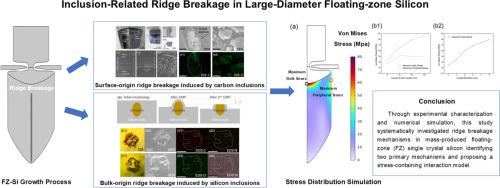Inclusion-related ridge breakage in large-diameter floating-zone silicon
IF 2.9
Q2 MATERIALS SCIENCE, MULTIDISCIPLINARY
引用次数: 0
Abstract
Large-diameter Floating-zone (FZ) silicon, particularly 8-inch crystals, is essential for high-voltage devices like insulated gate bipolar transistors (IGBTs) and fast recovery diodes (FRDs), yet its production is hindered by low crystal growth yield due to ridge breakage defects. This study investigates inclusion-induced ridge breakage mechanisms in mass-produced 8-inch FZ silicon, using 8-inch (100) and 5-inch (111) crystals, with the latter employed to study bulk defect propagation. Through scanning electron microscopy, energy-dispersive spectroscopy, and mechanochemical polishing, we identified two mechanisms: surface-origin carbon inclusions, likely silicon carbide particles from graphite wear at the initial heating stage, induce twin formation, while bulk-origin microcrystalline silicon inclusions trigger dislocations and cracks. Numerical simulations revealed that central and edge high-stress zones amplify inclusion effects, with stress scaling linearly with diameter, exacerbating breakage in 8-inch crystals. A stress-inclusion interaction model explains how inclusions narrow the tolerable stress window. These findings advocate optimizing preform rod preparation and heating processes to minimize inclusions, enhancing yield for 8-inch FZ silicon in high-performance electronics.

大直径浮带硅中包裹体相关脊状断裂
大直径浮动区(FZ)硅,特别是8英寸晶体,对于绝缘栅双极晶体管(igbt)和快速恢复二极管(frd)等高压器件至关重要,但由于脊断裂缺陷导致晶体生长成品率低,阻碍了其生产。本研究使用8英寸(100)和5英寸(111)晶体研究了量产8英寸FZ硅中夹杂诱导的脊断裂机制,后者用于研究体缺陷传播。通过扫描电子显微镜,能量色散光谱和机械化学抛光,我们确定了两种机制:表面来源的碳夹杂物,可能是在初始加热阶段石墨磨损产生的碳化硅颗粒,诱导孪晶形成,而大块来源的微晶硅夹杂物引发位错和裂纹。数值模拟表明,中央和边缘的高应力区放大了包裹体效应,应力随直径呈线性缩放,加剧了8英寸晶体的破裂。应力-包裹体相互作用模型解释了包裹体如何缩小可容忍应力窗口。这些发现提倡优化预制棒的制备和加热工艺,以最大限度地减少夹杂物,提高高性能电子产品中8英寸FZ硅的产量。
本文章由计算机程序翻译,如有差异,请以英文原文为准。
求助全文
约1分钟内获得全文
求助全文
来源期刊

Materialia
MATERIALS SCIENCE, MULTIDISCIPLINARY-
CiteScore
6.40
自引率
2.90%
发文量
345
审稿时长
36 days
期刊介绍:
Materialia is a multidisciplinary journal of materials science and engineering that publishes original peer-reviewed research articles. Articles in Materialia advance the understanding of the relationship between processing, structure, property, and function of materials.
Materialia publishes full-length research articles, review articles, and letters (short communications). In addition to receiving direct submissions, Materialia also accepts transfers from Acta Materialia, Inc. partner journals. Materialia offers authors the choice to publish on an open access model (with author fee), or on a subscription model (with no author fee).
 求助内容:
求助内容: 应助结果提醒方式:
应助结果提醒方式:


